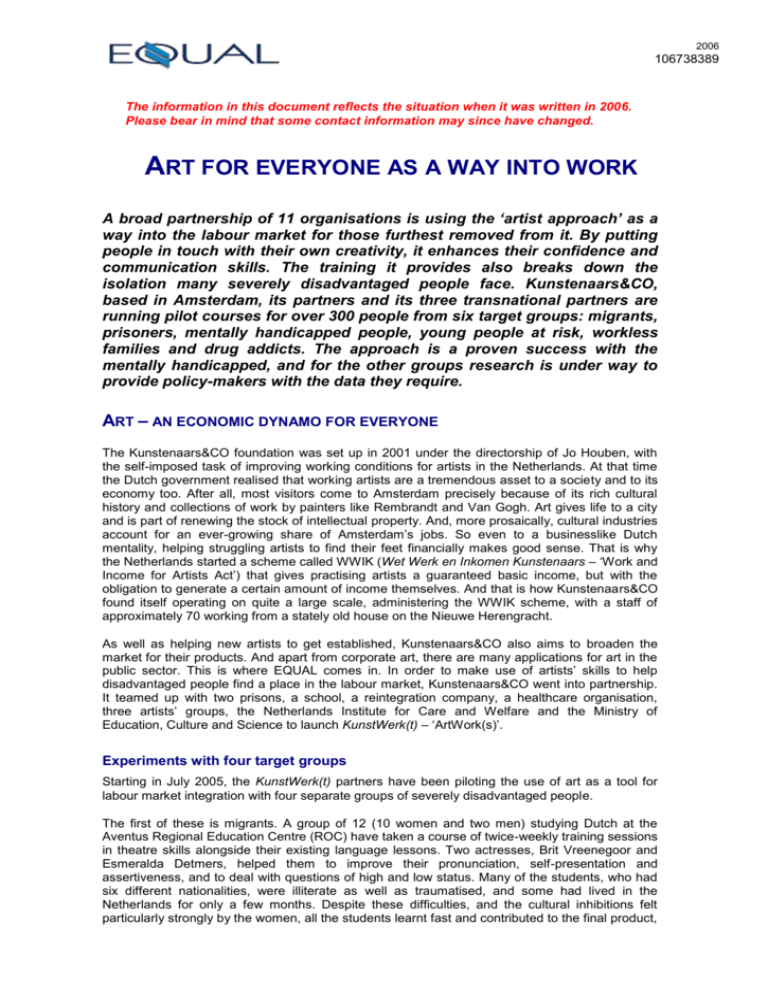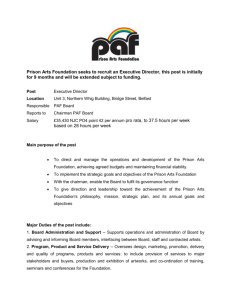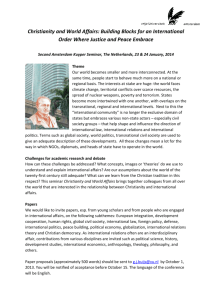Netherlands: Kunstenaars
advertisement

2006 106738389 The information in this document reflects the situation when it was written in 2006. Please bear in mind that some contact information may since have changed. ART FOR EVERYONE AS A WAY INTO WORK A broad partnership of 11 organisations is using the ‘artist approach’ as a way into the labour market for those furthest removed from it. By putting people in touch with their own creativity, it enhances their confidence and communication skills. The training it provides also breaks down the isolation many severely disadvantaged people face. Kunstenaars&CO, based in Amsterdam, its partners and its three transnational partners are running pilot courses for over 300 people from six target groups: migrants, prisoners, mentally handicapped people, young people at risk, workless families and drug addicts. The approach is a proven success with the mentally handicapped, and for the other groups research is under way to provide policy-makers with the data they require. ART – AN ECONOMIC DYNAMO FOR EVERYONE The Kunstenaars&CO foundation was set up in 2001 under the directorship of Jo Houben, with the self-imposed task of improving working conditions for artists in the Netherlands. At that time the Dutch government realised that working artists are a tremendous asset to a society and to its economy too. After all, most visitors come to Amsterdam precisely because of its rich cultural history and collections of work by painters like Rembrandt and Van Gogh. Art gives life to a city and is part of renewing the stock of intellectual property. And, more prosaically, cultural industries account for an ever-growing share of Amsterdam’s jobs. So even to a businesslike Dutch mentality, helping struggling artists to find their feet financially makes good sense. That is why the Netherlands started a scheme called WWIK (Wet Werk en Inkomen Kunstenaars – ‘Work and Income for Artists Act’) that gives practising artists a guaranteed basic income, but with the obligation to generate a certain amount of income themselves. And that is how Kunstenaars&CO found itself operating on quite a large scale, administering the WWIK scheme, with a staff of approximately 70 working from a stately old house on the Nieuwe Herengracht. As well as helping new artists to get established, Kunstenaars&CO also aims to broaden the market for their products. And apart from corporate art, there are many applications for art in the public sector. This is where EQUAL comes in. In order to make use of artists’ skills to help disadvantaged people find a place in the labour market, Kunstenaars&CO went into partnership. It teamed up with two prisons, a school, a reintegration company, a healthcare organisation, three artists’ groups, the Netherlands Institute for Care and Welfare and the Ministry of Education, Culture and Science to launch KunstWerk(t) – ‘ArtWork(s)’. Experiments with four target groups Starting in July 2005, the KunstWerk(t) partners have been piloting the use of art as a tool for labour market integration with four separate groups of severely disadvantaged people. The first of these is migrants. A group of 12 (10 women and two men) studying Dutch at the Aventus Regional Education Centre (ROC) have taken a course of twice-weekly training sessions in theatre skills alongside their existing language lessons. Two actresses, Brit Vreenegoor and Esmeralda Detmers, helped them to improve their pronunciation, self-presentation and assertiveness, and to deal with questions of high and low status. Many of the students, who had six different nationalities, were illiterate as well as traumatised, and some had lived in the Netherlands for only a few months. Despite these difficulties, and the cultural inhibitions felt particularly strongly by the women, all the students learnt fast and contributed to the final product, a video in which they introduce themselves in their native language and in Dutch. “Both the school and the artist were very pleased with the result,” says project manager Anne van Otterloo. “None of the women had ever worked outside the house before, but all the students undertook a work placement, for instance helping out at their children’s school, sometimes against heavy family pressure.” The second group is composed of 11 mentally handicapped people, who were working in the Ridderikhoff restaurant in Hoorn. Here, the acting input taught them to make a performance out of their job, enabling to meet clients’ specific needs and to pamper them. Thirdly, prisoners. Inmates at the Ter Peel women’s prison at Evertsoord near Venlo, on the German border, and the nearby Maashegge semi-open men’s prison (which holds men who are nearing the end of their sentences) were offered the opportunity to perform in a choir led by musicians Jos Zandvliet and Tommie Freke, and a group of up to 13 women and eight men volunteered. And fourthly, a group of 12 young people at risk and difficult to employ. These were selected for a series of theatre workshops from a group of 20 by FourstaR Reintegration Service and Stichting Parels voor de Zwijnen. In several weeks of rehearsals with theatre director Saskia Huijbrechtse, the group created the piece Leve Ik (‘Long Live Me’), based on their own experiences of love, money, work, parents and finding your place in society. This has been well received at venues including the prestigious Amsterdam arts festival Over het IJ, and if the Italian authorities permit, will tour to the Prison for Minors in Palermo in Sicily in December 2006. One problem was that it was difficult to enforce discipline and timekeeping, as actors could not be thrown off the cast as this would endanger the final performance. YOU CAN’T LIE WHEN YOU ARE SINGING Kunstenaars&CO demonstrated some of its work at the launch conference for the Skills through the Arts transnational partnership, which it organised from 30 March to 1 April 2006. The main part of the event took part at Amsterdam’s Theatre Institute, but the second day was actually held inside the Ter Peel prison – a testimony to the courage of the Dutch Ministry of Justice. The combined choirs from Ter Peel and Maashegge shuffled in dressed as a chain gang, and gave a very moving performance. It was a shame that, owing to security rules, it could not be filmed for posterity. One of the women performers who had been released even returned to prison for the day so that she could take part. “We made history today,” comments Ms Van Otterloo. “It is the first time that male prisoners have come into a women’s prison to give a joint performance.” She goes on to explain the project’s rationale: “Art taps the wells of a person’s creativity and gives them a way of expressing themselves. The choir is an example – singing is one way of communicating with other people, and once you have established a rapport through one medium you can generalise this to build a relationship. You can’t lie when you are singing." The governor of Maashegge prison, Willem Lingmont, said why it works from his point of view: “We have a long history of this type of activity and we know it works – the question is, can we afford the costs of running it, as budgets have been cut? I believe it makes a difference, and increases the chances of work in the future. One day everybody leaves prison, so the community benefits.” The 50 visiting delegates took part in various workshops to gain some direct experience of methodologies for working in an artistic way with disadvantaged people. One of these workshops, on drama, was run by Belgrade Theatre from Coventry in the UK, who are partners in the Participation for Employability (APE) project. It looked at building trust. After limbering up, the group moved on to collective games such as the ‘human knot’. In this exercise, the group stand in a circle, shut their eyes, and hold their hands out in front of them. Each person then grasps someone else’s hand with each of theirs – the ineluctable result being a big tangle of arms. What the group has to work out is how to disentangle themselves, without letting go of each other – and without spraining their wrists – and end up back in a circle, holding hands. “Getting untangled means you have to be able to mime and communicate non-verbally,” says drama co-ordinator Kerry Harvey, “so it’s a great way to improve trust and expression.” Amplifying this point, the group then brainstormed their ideas on what skills it takes to communicate well. 2 106738389 A song with your supper The conference participants had already had a truly memorable introduction to the arts as an employment policy tool, when they turned up for dinner at the Ridderikhoff restaurant 1 on the main square of the ancient port of Hoorn, on the west coast of the IJsselmeer. Arrayed on the front steps, and spilling over on to the redbrick square, were a dozen of the restaurant staff in their white overalls, singing songs of welcome to the accompaniment of a banjo, and serving glasses of the house cocktail. Former theatre artist Septimia Kuhlmann, from the ACCU Community Arts Foundation, is the secret ingredient in their working lives. For these staff members are people who would generally find it hard to get and keep a job, and the Ridderikhoff is a very special kind of employer. The restaurant is run by the Stichting Philadelphia Zorg 2 (Philadelphia Care Foundation), a major charity that cares for some 8,000 elderly and handicapped people at 650 sites across the Netherlands. “We opened six years ago under an agreement with the city council,” VicePresident drs. Theo Kralt explains. “This building was built in 1550 and is an architectural monument, and the local council had renovated it and needed to find an appropriate use for it. As it is right in the town centre, next door to the weigh house (Waag), using it as a restaurant was ideal: the location is central enough to attract enough customers to pay a commercial rent, and they could accomplish social goals as well. From our side, we wanted to move up a step in the business of reintegrating disadvantaged people into the world of work. We wanted to operate a high-class restaurant but with a workforce including mentally disabled people. But we don’t compromise on service levels – in fact our staff’s enthusiasm adds an extra dimension. Sometimes a staff member might surprise a customer by asking them what they see as a personal question, but they usually take it in good part.” As a social enterprise, the Ridderikhoff meets a market demand for high-class meals in an original and congenial setting, and uses the profit it makes to create a social benefit. It employs a quota of mentally handicapped people, giving them a place in the workforce that suits their specific needs. Restaurant manager Henk Pannekoek explains how conscience and competition can be combined: “We are a commercial operation. Most of our staff are professionals, and two-thirds of our income is from sales,” he explains. “To top this up we receive a wage subsidy from the government in respect of our handicapped employees, who work partA choral welcome to De Ridderikhoff, a social time. This way we can guarantee enterprise restaurant in Hoorn, Netherlands consistent high levels of service to our customers, and still give the trainees the care they need. Eventually we hope they will leave for other jobs, but most of them would love to stay on for ever.” CONVINCING FIGURES KunstWerk(t)’s initiatives are certainly a model for replication elsewhere, and the results have been taken up by the website and magazine of NIZW, the Netherlands Institute for Care and Welfare.3 The work will be documented in a number of ways: the Hungarian and Italian partners are each making a film, and there will also be a book and a CD to describe the various artistic methodologies. Stichting Philadelphia Zorg is sufficiently impressed with the results at the 1 www.ridderikhoff.org www.philadelphia.nl 3 www.nizw.nl 2 3 106738389 Ridderikhoff in Hoorn that they are following it up with another arts-based training programme at their teahouse in Monnikendam, just along the coast. As regards influencing policy, progress is slower. “We hope that the Regional Education Centres (ROCs) will recognise the useful role a theatrical method can play in language teaching, for instance in studying for the new compulsory citizenship examinations,” says Ms Van Otterloo. “We’ve brought the EQUAL national network on entrepreneurship on board to make an approach to educational policy-makers.” Unfortunately, halfway through the project, a new governor took over the Ter Peel prison, and the regime changed nationally. “Daytime working hours were extended, and after 5 p.m. all the prisoners have to be in their cells. So there is just no time left for artistic activity,” Ms Van Otterloo admits. “This means that although the ministry has said that it is ready to look at our research findings, at the moment we cannot collect the data we need on this target group. Luckily, we shall be able to restart the project later this year at the Bijlmer men’s prison in Amsterdam, and the research can continue.” However the picture is not so gloomy on the other side of the North Sea. Randel Barrows, a visiting adviser to the British Probation Service, views art as an important aid to getting ex-prisoners into employment, and thus meeting one of the targets of Britain’s reoffending strategy, to reduce recidivism by 10% over four years. Art can make a particular difference in altering offenders’ thinking and behaviour, which are just as important in reintegration as ‘harder’ factors like accommodation, debt or the family situation. A powerful tool for getting the arguments across will be the research results, which will be ready in 2007. A research team, led by the SCO-Kohnstamm Institute of Amsterdam University, is attached to each of the four partners in the transnational Skills through the Arts partnership. This brings together a sample of over 300 beneficiaries of six different types – the four studied in the Netherlands, plus workless households, who are taking part in the British project, and a Hungarian group of drug addicts. Data are being collected by observation, questionnaires, interviews and focus groups. The researchers have agreed a common methodology, based on measuring each beneficiary’s ‘distance travelled’ – that is, how their capabilities have increased during the project. In fact the project has decided to take three measurements – at the beginning, midpoint and end, and to measure a standardised set of ‘core competences’ such as presentation, time management, ability to collaborate and ability to deal with differences in status. These social skills make an important contribution to a person’s employability. DP name: KunstWerk(t) in de Tertiaire Sector – ArtWork(s) in the Third Sector DP ID: NL-2004/EQD/0008 National partners: Kunstenaars &CO; Fourstar Reinegratie Service bv; Ministerie van Justitie/ DJIPI Zuid-Oost/Maashegge; Ministerie van Onderwijs, Cultuur en Wetenschap; Nederlands Instituut voor Zorg en Welzijn (NIZW); ROC Aventus; Stichting Parels voor de Zwijnen; Stichting Philadelphia Zorg; Stichting ACCU; Stichting Alice Transnational partnership: TCA 4427 Skills through the Arts – partners: UKgb-80 Arts Participation for Employability (APE), HU-36 Akiket kezd elveszíteni az élet (‘Lost by Life’), IT-ITG2-SIC-086 On Stage Contact: Anne van Otterloo Address: Kunstenaars&CO, Nieuwe Herengracht 119, NL-1011 SB Amsterdam, Netherlands Telephone: +31 20 530 5935 (direct); +31 20 535 2500 (switchboard) E-mail: avanotterloo@kunstenaarsenco.nl Website: www.kunstenaarsenco.nl 4 106738389





